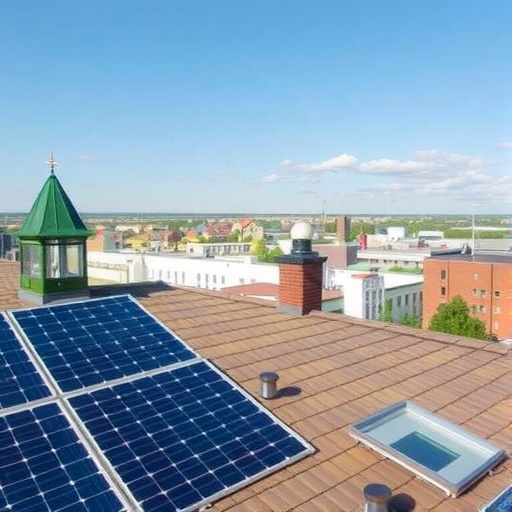In recent years, rooftop solar installations have been heralded as a cornerstone of global climate mitigation strategies, touted for their capacity to significantly reduce greenhouse gas emissions by displacing fossil fuel-based electricity generation. However, an emerging body of research suggests that the emissions reductions attributed to rooftop solar may be substantially overstated. A new study led by James E.T. Bistline and Alexandra Watten, to be published in Nature Climate Change in 2025, delves into the complexities of emissions accounting and reveals that conventional approaches fail to adequately capture critical substitution effects, leading to inflated estimates of emission savings.
At the heart of this research is the understanding that the electricity grid operates as a complex and dynamic system where generation sources continuously compete and interact. The simplistic assumption that rooftop solar generation directly replaces emissions-intensive power plants overlooks the nuanced interplay within the grid. For instance, solar generation might substitute for different types of power plants throughout the day, each with varying emissions profiles and operational flexibilities. This dynamic substitution pattern changes how emissions reductions should be computed and understood.
Traditional assessments of rooftop solar benefits often use average emissions factors—essentially an average emissions rate across the grid—multiplying these by solar-generated electricity to estimate avoided emissions. However, these averages obscure the preferential displacement of certain fossil fuel sources. Renewable generation does not replace coal, natural gas, or oil-fired plants uniformly; instead, it tends to substitute the marginal generation sources, which could be more or less carbon-intensive depending on real-time demand and supply conditions.
Bistline and Watten’s analysis harnesses intricate grid modeling tools combined with empirical data to infer the actual marginal units that rooftop solar offsets across different regions and times. Their results indicate that the average approach overestimates emission reductions by failing to consider that some displaced generation is cleaner—like natural gas plants equipped with modern emissions controls—rather than the more carbon-laden coal plants generally assumed. This distinction markedly changes the net climate benefit of rooftop solar.
Moreover, the study highlights that rooftop solar’s impact varies not only temporally but spatially. The emissions intensity of the displaced grid power differs across electricity markets and evolves with grid decarbonization efforts. Regions with more renewable penetration may see diminishing returns from additional rooftop solar, as the marginal avoided emissions dip over time. This time-dependent substitution effect introduces complexities in projecting rooftop solar’s long-term climate contributions.
Beyond emission factors, the operational characteristics of different power plants influence substitution dynamics. Flexible generators like gas turbines can ramp up and down quickly and often act as balancing resources supporting variable renewable energy. When rooftop solar production peaks during midday, flexible gas plants may reduce output, but baseload plants, which cannot easily adjust output, continue running. This partial displacement means emission reductions from rooftop solar may be less than previously assumed in models that do not explicitly incorporate operational constraints.
The financial incentives and policy frameworks encouraging rooftop solar installation have largely been justified based on optimistic emission reduction estimates. Consequently, energy policymakers and stakeholders may need to recalibrate expectations about rooftop solar’s climate benefits. A nuanced understanding of how substitution effects alter emissions outcomes could help optimize investments in renewable technologies and grid infrastructure.
This study’s findings do not diminish the importance of rooftop solar in the renewable energy portfolio but call for more refined accounting methods. More precise quantification of substitution effects can guide grid planners and policy makers in designing incentives that maximize climate benefits, possibly coupling rooftop solar with energy storage or smart grid technologies to enhance dispatchability and increase actual emissions avoided.
Furthermore, the research underscores the need for high-resolution data and sophisticated modeling frameworks that capture real-time grid conditions and generation unit characteristics. Such tools allow capturing the spatial-temporal heterogeneity in grid operations, vital for accurate assessments of rooftop solar’s true emissions impact.
Critically, the authors caution against blanket declarations that rooftop solar invariably yields large-scale emissions reductions. Instead, their work advocates for context-specific evaluations that take into account regional grid emissions profiles, generation mix, and operational dynamics. This approach promises better alignment of renewable energy policy with actual environmental outcomes.
As the electricity system worldwide trends towards greater renewable penetration, integrating rooftop solar with other decarbonization measures such as grid-scale renewables, demand-side management, and energy storage can address some drawbacks identified. Cooperative interactions between these technologies might help overcome substitution inefficiencies and improve net emissions reductions.
In conclusion, Bistline and Watten’s study presents a vital recalibration in how rooftop solar’s climate benefits are assessed. By revealing the significant role of substitution effects and operational realities of grid dispatch, they provide a compelling argument for enhanced methodologies that go beyond average emissions factors. Such precision is imperative for directing investments and policies that genuinely accelerate the transition to a low-carbon energy future.
Their contribution elevates the conversation in climate policy and energy systems research, signaling a pivot away from simplistic arithmetic emission reduction estimates towards more systemic, data-driven analyses. This progression embodies the scientific rigor necessary to underpin effective mitigation strategies in the complex landscape of contemporary electricity grids.
As rooftop solar continues to proliferate globally, this deeper understanding ensures that its deployment is guided not just by capacity installed but by actual climate impact achieved, reinforcing the urgency to optimize every megawatt of renewable generation in the race to limit global warming.
Subject of Research: Emissions accounting in rooftop solar and grid electricity substitution effects
Article Title: Emissions reductions of rooftop solar are overstated by approaches that inadequately capture substitution effects
Article References:
Bistline, J.E.T., Watten, A. Emissions reductions of rooftop solar are overstated by approaches that inadequately capture substitution effects. Nat. Clim. Chang. (2025). https://doi.org/10.1038/s41558-025-02459-y
Image Credits: AI Generated




